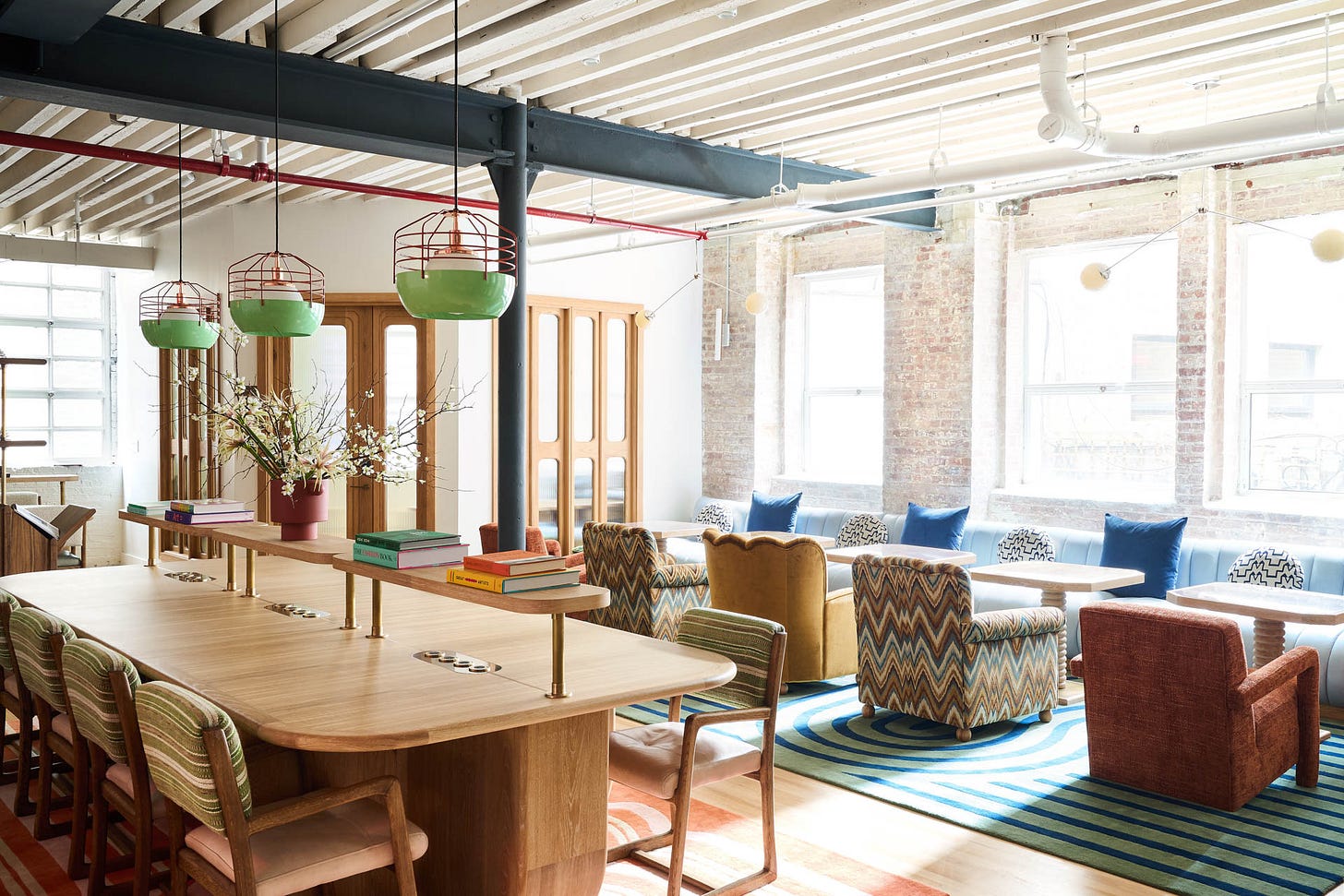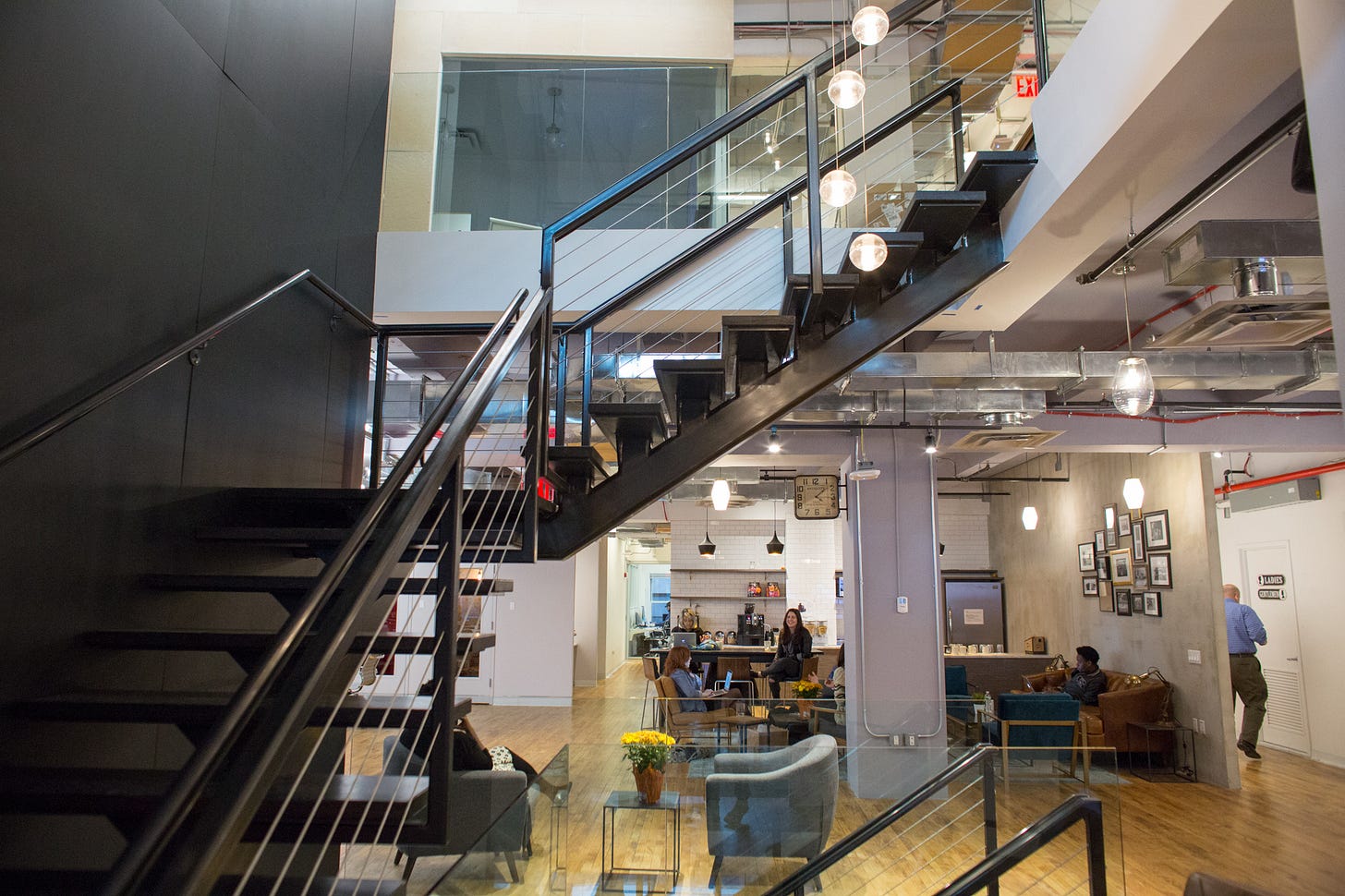This past April, the small Thesis Driven team—three strong on the west side of Manhattan—went shopping for coworking space.
It was an unmitigated disaster.
Like many things in business that go awry, I started with the assumption that it would be easy. We are, after all, Thesis Driven. We’re plugged into the forefront of the future of work, managed office, and commercial real estate in New York. A number of “flex office” CEOs are personal friends. Getting a few desks at a reasonable price in Manhattan would be no trouble at all.
Or so I thought.
But coworking has come a long way since the days of hot desking at General Assembly in 2010. “Coworking” has been replaced by “flex office,” with the largest and savviest operators—firms like Industrious, Convene, and Regus—eschewing one-off desk rentals in favor of “enterprise solutions,” managed office services packages sold at a global scale to Fortune 1000 companies.
And that is, no doubt, a better business.
But it has left a WeWork-shaped hole in the market. As venture-backed operators sought scalable opportunities, they left the old rent-a-desk coworking model behind. On top of that, the media storm of tsk-tsking journalists and Thought Leaders covering WeWork’s demise soured a generation of entrepreneurs on the old coworking model. Today’s consensus view is that coworking is a terrible business.
Which makes it a perfect time to bring it back.
Embarrassing Myself
Asking a real estate writer (me) to find three desks at a reasonable price in Chelsea is like asking a biologist to do brain surgery. Sure, they understand the concept and general structure of a brain. They can name the parts, how it should look, what it does; perhaps they dissected a pig in college and have some vague recollection of how that all goes. But when it comes time to slice into the squishy, fibrous mass, it’s a whole different game and all that education goes out the window.
But that didn’t stop me from believing that I could nail down three desks in an afternoon. The first place we visited seemed friendly enough; we had gotten a warm intro to the operator who pitched it over the phone like a sort of co-op. He was “curating good friends”, good vibes, ambitious people. Everyone “chipped in to pay for part of the Wi-Fi.” When I finally met the operator in person, I was pitched Andrew Cuomo’s candidacy for mayor and quoted $1,000 per desk per month. The Wi-Fi is, apparently, exceptional.
We also checked out the usual suspects. WeWork appeared in operational disarray. Despite booking a visit, the person giving the tour had only a vague sense of what was available and even less conviction as to its pricing. Another coworking operator attempted to cancel our tour at the last minute, citing staffing issues. We got a very pleasant reception at Industrious but were dismayed to learn they don’t offer desk rentals at most locations.
We initially decided to go with an off-brand operator offering a very affordable—albeit uncool—space in a great Flatiron location. Unfortunately, the internet was completely unworkable, dropping video calls every 5 to 10 minutes. The staff seemed to acknowledge that this was a considerable flaw in their product and—two days after signing—agreed to rip up our lease in exchange for never hearing from us again.
Defeated, I handed the search over to our new Chief of Staff, Kam. Under her leadership we settled on a nice little spot at the Malin in the West Village, a lovely space about as far as you can get from a subway in Manhattan without being on a lettered avenue.
But at least the internet works.
Coworking in Context
While the collapse of the coworking market in New York is jarring, it’s not entirely surprising given the arc of what is now known as the “flex office” sector.
Prior to 2012 or so, all shared and flex office models were simply lumped together as “coworking.” Regus offered small private suites in sterile, 1990s-vintage environments, while newer players like WeWork—and dozens of smaller operators—allowed freelancers, entrepreneurs, and small startups to rent desks or 2-to-10 person glass cubes in more aesthetically pleasing environments.
But a few things happened in the years that followed that broke the old coworking model.
One, venture capital decided to love brick-and mortar businesses. The coworking players with ambition to scale—WeWork, Industrious, Convene, Knotel, and a number of others—all took significant outside capital to accelerate growth. Coworking, after all, was a somewhat capital-intensive business, with new leases each requiring security deposits and FF&E investments, and new locations were often unprofitable for some time before stabilizing. WeWork’s meteoric rise fueled interest in the sector with a number of strategic investors joining the fray.
Of course, coworking executives as well as their investors understood that renting desks month-to-month to freelancers and startups was not a particularly scalable business. Those customers had low willingness to pay and were limited in number. On top of that, many investors fretted about the duration mismatch between long-term lease liabilities and short-term customers.
Fortunately, the enterprise world was undergoing a parallel transformation that would give coworking operators a path to greener—and higher TAM—pastures.
Increasingly, large companies saw office management as a distraction that should be outsourced. Why, after all, should a company specializing in software development or widget production or accounting services also have a core competency in office management? Just as they would outsource legal work to a law firm, they should outsource office management to an office management firm.
Accounting rule changes announced in 2016 further catalyzed change by forcing companies to keep leases longer than 12 months as liabilities on their balance sheet, eroding the traditional long-term lease office model as large firms sought to keep their balance sheets unencumbered.
Suddenly, coworking operators had found new life as “flex office” companies, providing enterprise clients with an outsourced office function as well as balance sheet relief. Firms like Industrious and WeWork became outsourced real estate behemoths, molding themselves into experts in what the modern office should be. The pandemic and rise of remote work only made that role more important as executives struggled to figure out how to coax employees back—or rethink the office entirely.
Unfortunately for the freelancers and small startups of the world, the enterprise flex office model is neither compatible nor synergistic with the old rent-a-desk business. As WeWork and Industrious pursued Fortune 500 clients, the traditional coworking business was left to a menagerie of small, local, poorly-capitalized operators.
The “coworking” companies that remained, therefore, were totally unprepared to weather the storm that arrived in March of 2020. Most of the coworking operators that did not complete the “flex office” pivot were wiped out by the pandemic. For instance, my wife’s startup operated out of Alley—a small, independent coworking space in Chelsea, Manhattan—prior to it going belly up in 2021. Their flagship coworking space on 24th and 7th was eventually absorbed into Industrious.
On top of all that, negative narratives convinced investors and entrepreneurs who cared about their reputations to steer clear of the coworking business. The beer kegs, the weed, the summer camps, the millennials with laptops, the bankruptcies: coworking was not a category for serious businesspeople.
Putting Jamie on the Spot
I had the pleasure of having Industrious co-founder and CEO Jamie Hodari on the Thesis Driven Leader Series a few weeks back. He’s now CEO of Building Operations and Experience at CBRE, the real estate services behemoth, after the firm’s $800 million acquisition of Industrious consummated earlier this year.
Hodari is one of my favorite people in real estate. We probably sat on 20 panels together between 2015 and 2022—event organizers loved to do the “co-working and co-living” theme—and I’ve been continuously impressed with how he built Industrious and “won” the flex office race. But Industrious’s successful focus on the enterprise nonetheless was a nail in the coffin of the old coworking model, and it has left a hole in the market.
Surprisingly, he didn’t disagree with me. Here’s how the conversation went down:
Brad Hargreaves: WeWork, Serendipity, Industrious, most of them, when they started certainly had this more identity of quasi coworking. You can rent an office, you can rent a desk, and that's been deemphasized over time and for good reason. It feels like many of those companies have said, “we're going to serve enterprise clients.” [..] I think what that's done has left an opening that if someone went today and created 2012-era WeWork, it would actually do really well. Obviously you can't raise venture dollars. It's not gonna trade at a crazy multiple, but man, the options for “Hey, I need to rent like four desks" are pretty limited right now.
Jamie Hodari: That is dead on. And I actually think from a product point of view, you're right as well. There are starting to be more and more people that are like, “Hey, at three people, do I really wanna be in a tiny glass box?” I actually would prefer to get a membership where I'm in a beautiful common area as long as I have phone rooms and meeting rooms and private offices that I can book by the hour when I need it.
And I think that's gonna be very cool because you can do more interesting things with the design. In certain ways 2012 with 2025 technology is a dream combination. Because in 2012, if you took an open floor plan coworking seat, you're scrambling to try to find a meeting room and you're walking around with your laptop. But now the software is good enough that it can say, “Hey, I know your two o'clock is actually a Zoom call. You're in phone booth 12 at two o'clock.” There's just so much more you can do right now to make that a seamless, more delightful experience.
With a $36 billion market cap and hundreds of Fortune 1000 clients, restarting WeWork circa 2012 is unlikely to be on CBRE’s bingo card. But despite his focus on enterprise customers, Hodari sees the gap in the market.
To a Better Coworking Model
As Hodari says, there’s little to be gained by simply replicating the 2012-era coworking business. Fortunately, technology, the capital markets, and the office market have all evolved over the past 13 years in ways that could make the concept more viable.
Technology
As Hodari noted, technology is a lot smarter today than it was during coworking’s heyday. While the proliferation of Zoom calls doesn’t seem compatible with traditional coworking, the kind of AI room booking assistant Hodari proposes—as well as hardware like Room, which didn’t exist 10 years ago—can vastly improve the experience. Sensor data also makes understanding occupancy in real-time easier.
Technology is also making self-serve, unstaffed coworking businesses increasingly viable. Work Heights, for instance, has a low-touch, Airbnb-like approach: just get a code and go.
And all of this tech is far cheaper than it was in 2012.
Capital markets
But the most significant flaw in the old coworking model was how it was capitalized: often, by venture dollars. But today’s entrepreneurs have more options.
One, OpCo-PropCo and other platform investment models have expanded beyond their hospitality origins and are now seen across innovative real estate sectors including office. Interestingly, Industrious got its start raising capital asset-by-asset. “We funded them at the unit level—people put money into Industrious Philadelphia or Industrious St. Louis and then basically got a preferred return from the cash that threw off,” said Hodari. “It was basically a bootstrapped PropCo.”
New models like lease securitization provide another route, providing asset-specific financing through SPVs to capitalize growth without balance sheet liability or large capital outlays on the part of the OpCo.
And the emergence of flex office has had one positive downstream effect on the coworking opportunity: office landlords are now far more conditioned to accept management agreements, a non-starter for almost any office owner just a decade ago. But the dislocation in the market over the past five years—particularly WeWork’s bankruptcy—showed that leases may not be quite as stable and steady as they initially appear, and having a few floors operating under a management agreement isn’t a total deal-killer for real estate lenders. Without the burden of security deposits, FF&E investments, and long-term master leases, the coworking business looks far more compelling.
Some of that shift in owner sentiment, of course, is due to changes in the underlying office market.
The office market
The office sector has become an extreme of haves and have nots.
High-end, amenitized, and boutique offices are succeeding with high occupancies and rising rents. Office tenants—including flex office operators—want the kind of spaces that will entice workers back to the office.
The Class B and C market, on the other hand, is in deep trouble. Vacancies continue to rise as leases roll, and many Class B/C assets are simply obsolete. Owners and lenders may kick the can down the road by extending maturing notes, but the market for those assets is unlikely to recover.
And that’s a good thing for anyone who wants to build a coworking business. The Class B and C market is slowly unsticking as lenders lose patience. Unburdened by historic valuations—and capital stacks—new owners are free to accept lower and less predictable revenue per square foot from less-desirable operators like coworking companies. While drab low-rise office buildings on the outskirts of Chicago and Houston may be unusable for anyone and should be demolished, Class B office assets in midtown Manhattan, San Francisco, and downtown LA are prime candidates for a low-basis coworking renaissance.
—
Humans are a social species. When the “second space”—the office—declined, many anticipating that third spaces would rise to take its place. But that never really happened, at least in the way many predicted.
So as the office is reincarnated in new form, the need for “coworking” stronger than ever.
“I don't wanna oversell the ability of the workplace, either coworking more narrowly or workplaces in general, to overcome really scary, consistent, and what appear to be quite durable cultural trends like the loneliness, epidemic, isolation, people feeling stuck in their houses, stuck in their lives,” said Hodari. “But they're one of a very small number of potential bulwarks against them. And I'm not embarrassed about that. I don't have mixed feelings about that.”
Coworking has lived and died before, and it shall live again.
—Brad Hargreaves








Gotta speak more to Switchyards. They are the pinnacle of this and selling new locations out (even in other markets) in less than 10 mins.
Thank you Brad. I'd add the other boost has been the market education generally as to what coworking / shared office even is. As you know we're operating in regional and neighbourhood markets and they feel about 10 years behind but even they have all heard of WeWork... with its negative connotations there is also something very desirable and cool (and I think that speaks to a slight nostalgia for the enthusiasm of the pre-covid era in general).